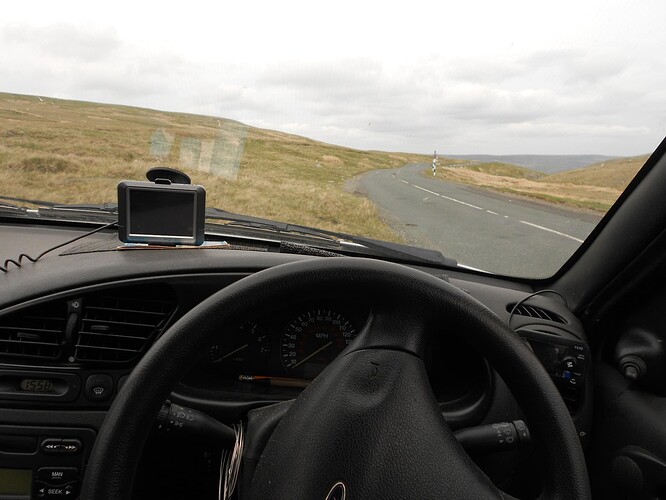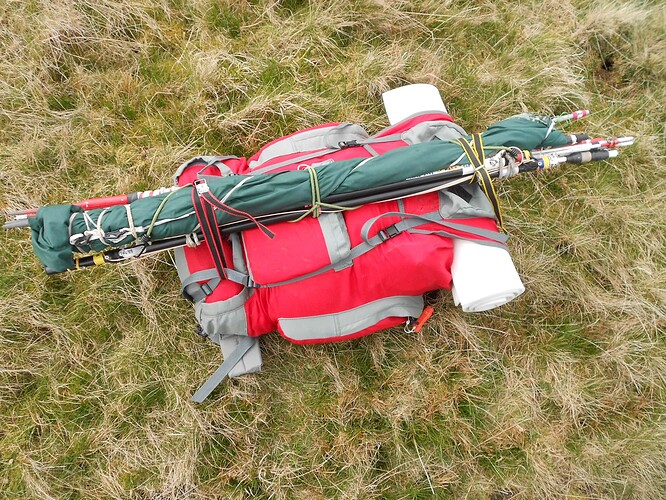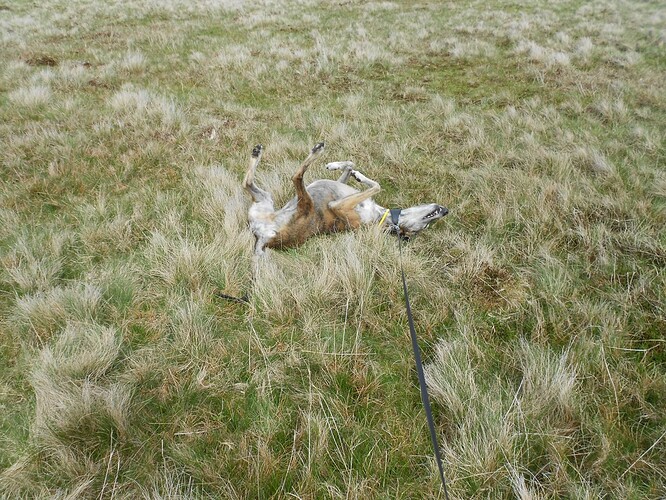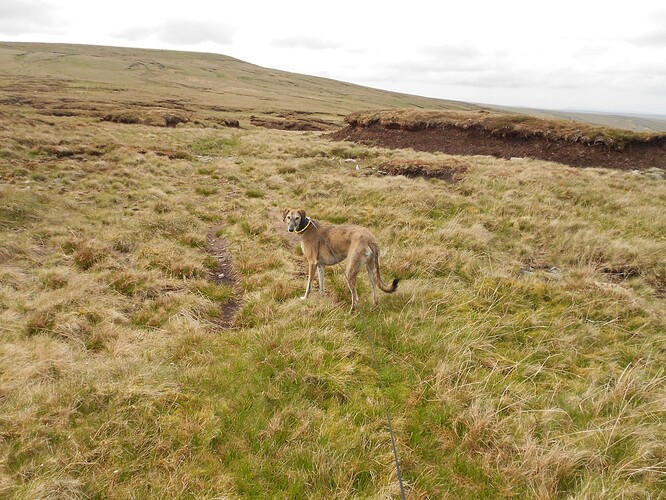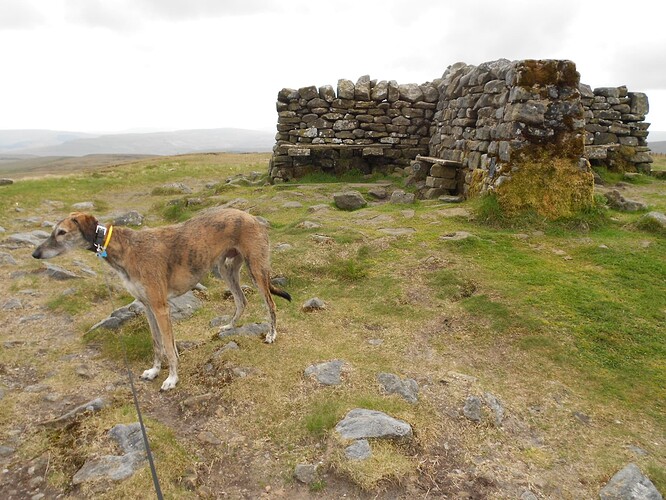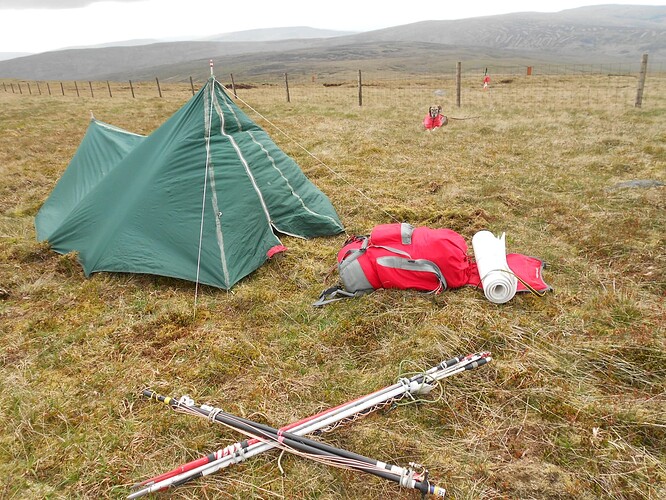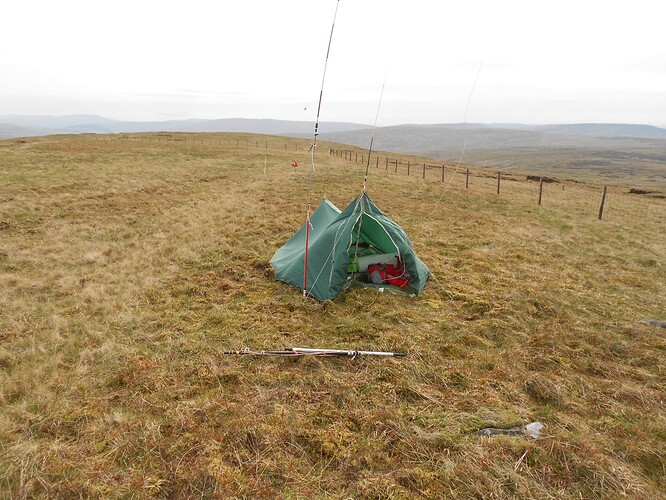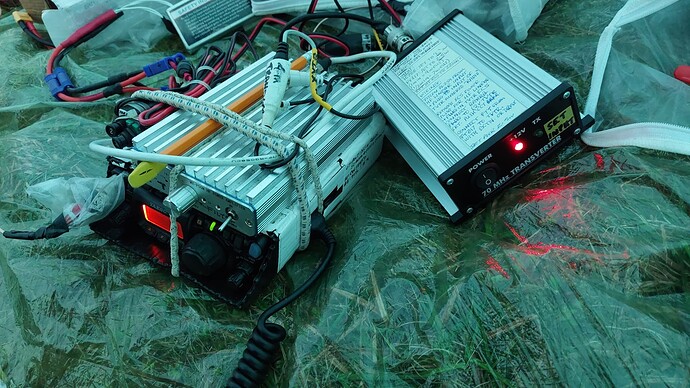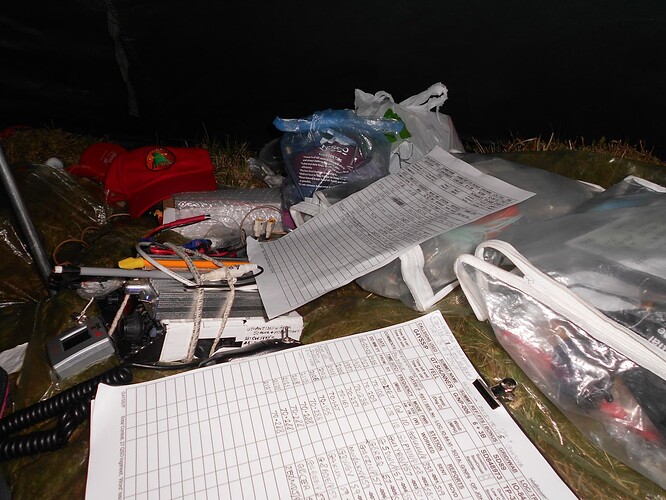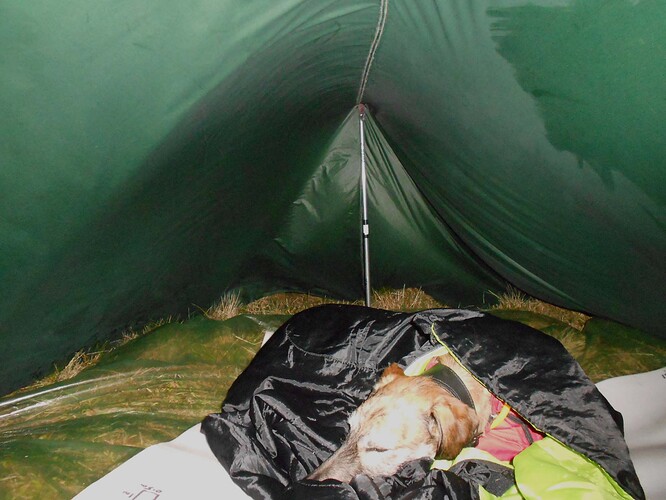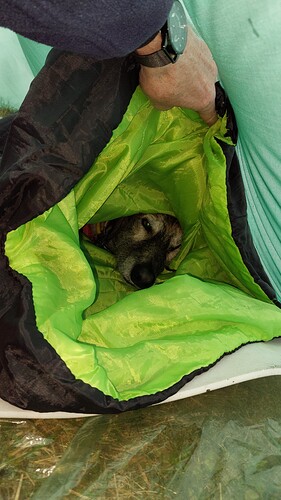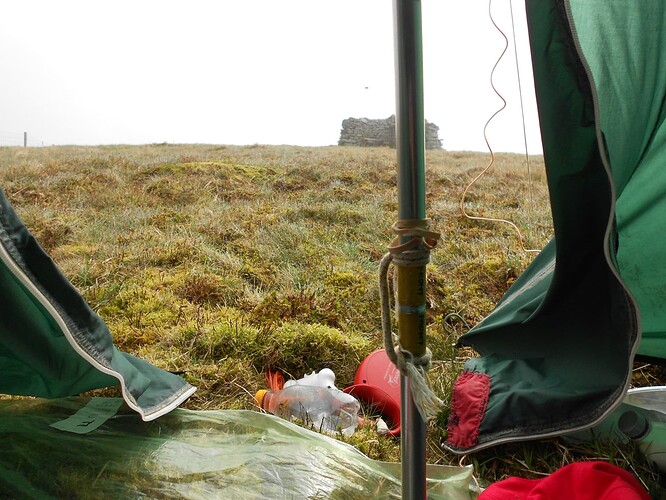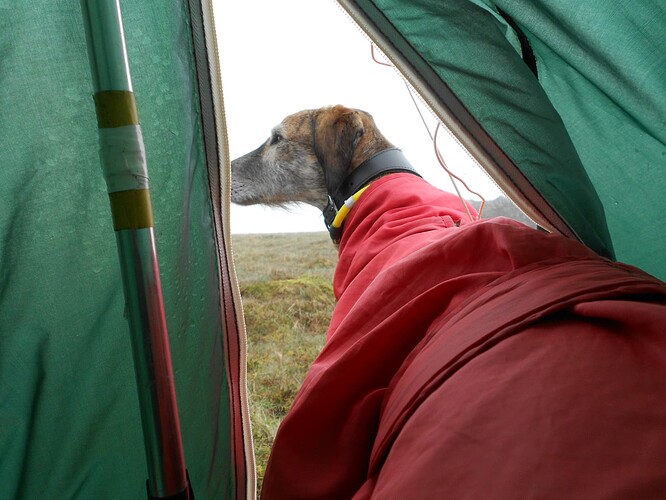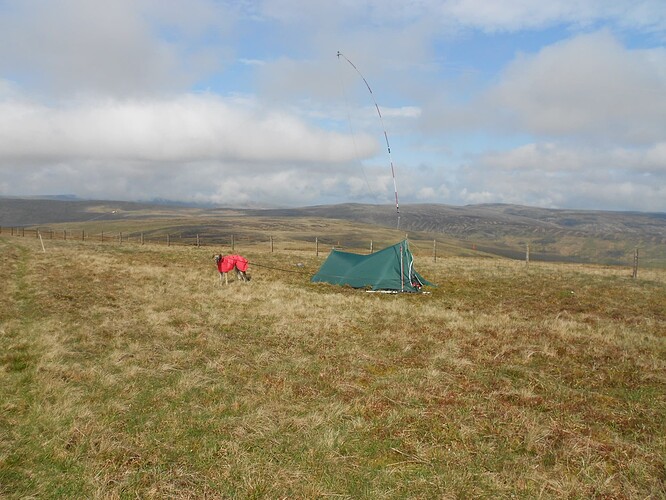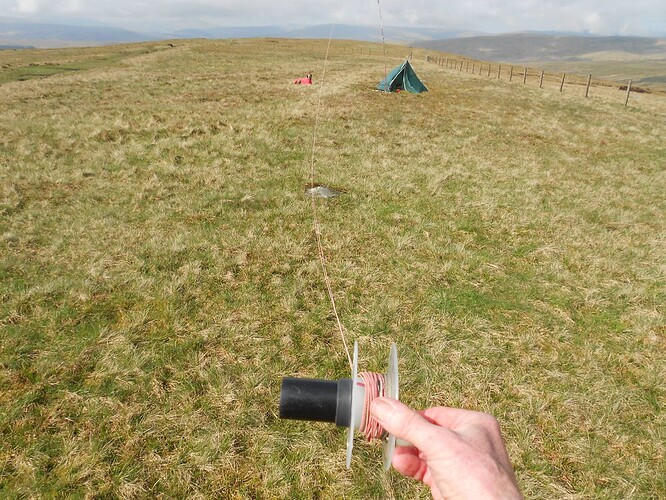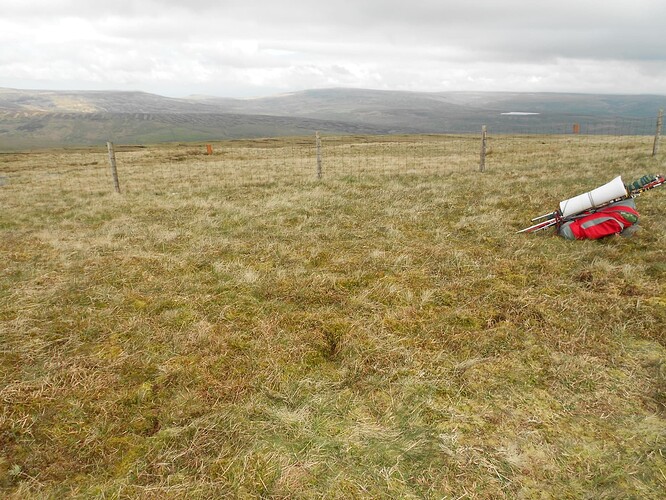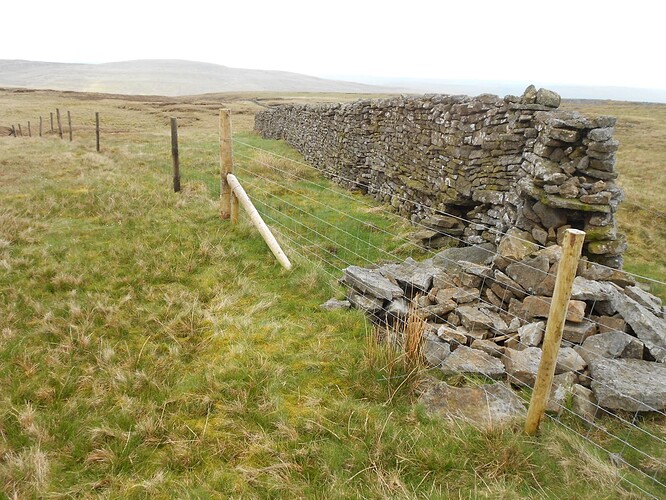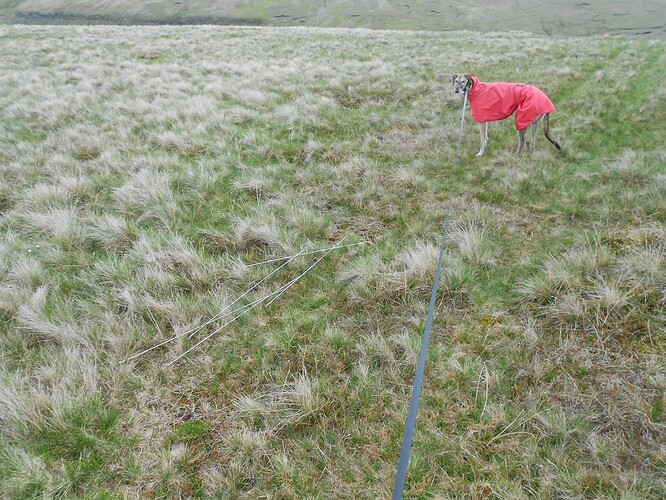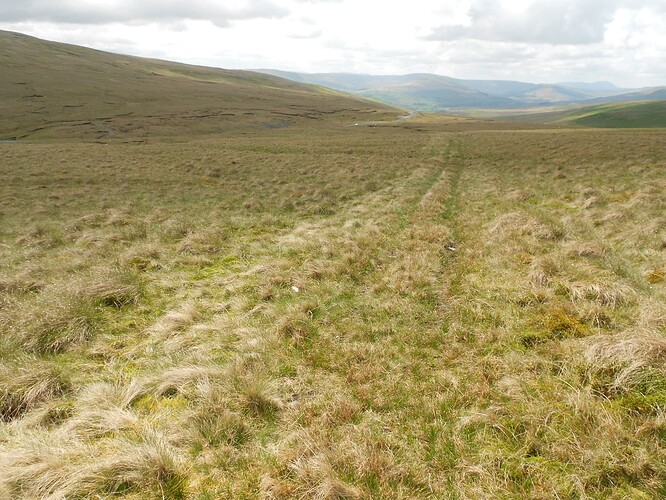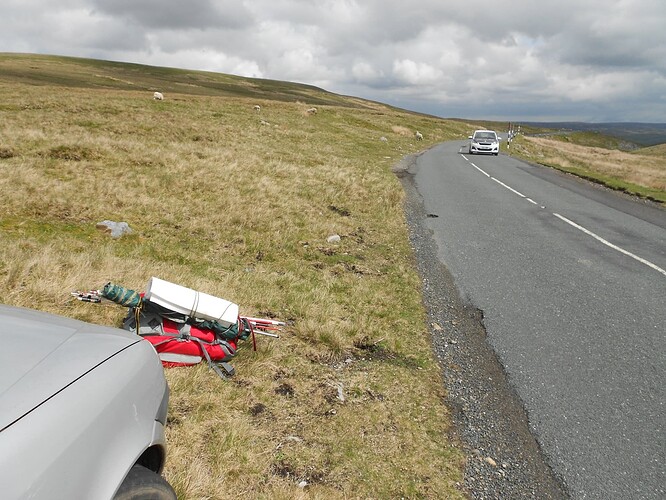Issue-1 (pse rprt errors?)
G/NP-006 Gt.SHUNNER FELL SUMMIT CAMP with Finn
QRO on 160m-80m-20m & QRP on 4m-CW/ SSB, 2m-FM
Using G4YSS/P for SOTA and the 70 MHz UKAC contest evening
Accompanied by Finn (Grandson’s Lurcher; 67% Greyhound/ 33% Saluki)
Overnight Summit Camp 18 th to 19 th of May 2023
Times:
BST (UTC+1hr) for walking etc.
UTC for radio operations (denoted ‘z’)
Sun Times: 21:12 & 04:56 BST
EQUIPMENT:
HF:
FT817ND HF/VHF/UHF 5W Transceiver
MX-P50M HF 50 Watt Linear Amplifier (80 thru 10) with 160m capability
Adjustable link dipole for 80-60-40-(30)-20 with loading coils for 160m
6m home-brew 5-section CFC/ alloy mast with 1m end sticks
VHF:
Transverter 10W (Ukraine), 70MHz from 28MHz/ 2.5W i/p. 400gm inc leads & 2 Amp CB
3-ele Home-Brew Yagi (480gm) based on up-scaled Sotabeam, see note below
PVC tube extension for use atop lower three sections of HF mast see note below
2m Band Vertical J-Pole on front tent pole
Two 11.1V, 5 Ah HRB Li-Po batteries
Note: 4m Yagi could not be used
Reserves:
Baofeng UV-5R 2m/ 70cm 5W VHF Handheld (not used)
Baofeng UV-3R 2m/ 70cm 2W VHF Handheld (listening)
Camping:
Viper-2 Ridge tent – 1988 (flysheet only with separate poly groundsheet)
Sleeping bag Mtn. Eqpt. Nova-2 synthetic 1.2kg
Sleeping bag synthetic (Finn) 0.7kg
Sleeping mat half length foam (G4YSS)
Sleeping mat half length foam (Finn)
Gore-Tex Bootees worn for use around camp
Pack-weight: 18.6kg (41 pounds) inc. 2.75 ltr fluids
INTRODUCTION:
The plan was to take part in the RSGB UKAC 70 MHz VHF contest evening and to do some 160m dark operating for SOTA. This is broadly a repeat of the NP6 summit camp of 16th and 17th July 2021 but with some minuses. SOTA summit camps take a lot of organizing and need great attention to detail. As occurred here, one tiny overlook can significantly change the scope and aims. In this case I can’t blame the checklist; the mistake was operational.
G/NP-006 Great Shunner Fell was chosen again because it’s not too steep to climb with a heavy load and its grassy top takes tent pegs and masts fairly well. Finn and I have camped on it before and because it overlooks many of the target areas. G/NP-004 Whernside was the other summit considered but whilst it is arguably more suitable, it involves a longer drive from Scarborough. For reasons I will mention later I am very grateful it wasn’t selected in this instance.
Previous experiences with UKAC 4m-band evening contests include:
G/NP-004 in 2018, for which the 3-ele beam was constructed and G/NP-006 in 2021.
The 4m Yagi consists of a 20mm dia x 2m long PVC conduit boom and six 1/8 inch aluminium welding rods. The boom is in two parts for carrying and to house the elements. It was built to adapt into a 4-ele beam for 2m when required. The design is a straight upscale of the original G3CWI 2m-band Sotabeam, which is not made anymore.
As a hardcore of chasers on the band know, 160m SOTA activating has been a speciality of mine since 2004. The two-and-a-half-hour VHF contests go on until 10:30pm which fits well with the full darkness requirement for good propagation on 160. Contest until 10:30 pm followed by 160m at 11pm has become the pattern.
WEATHER - MWIS mountain forecast:
When you’re camping at height and staying up to 18 hours, weather takes on a greater than normal importance. Considering the UK weather, finding a window that wide can be difficult. We were lucky.
Thursday afternoon: 7C rising to 10C at 700m ASL. West wind 10 to 15 mph with 25 mph gusts. Hazy sun. Rain unlikely until well into night.
Friday morning: 6C rising to 9C at 700m ASL. Northerly wind 15mph. Sun & cloud. Probably no rain in morning.
NP6 ROUTE (again for completeness):
Park at SD 8688 9570 on Buttertubs Pass. Follow the quad track all the way. It loops round via Coal Pit, Grimy Gutter Hags, Grainy Gill Moss and Little Shunner Fell, mainly following to the right of a fence.
Go via Coal Pit to the fence corner at SD 8694 9639 (turn left). The fence bends again at SD 8680 9653 at Grimy Gutter Hags. There’s another direction change - left (WSW) at SD 8586 9707. The track passes the end of a wall at SD 8542 9687 and after some steep sections you eventually reach a stile at SD 8503 9723 – a short cut to the summit shelter. Alternatively carry on beside the fence on a better path turning left to follow the paved Pennine Way a very short distance. A gate provides access to the summit. 200m of ascent, 2.2 miles one way and about an hour.
EXECUTION:
Starting at 13:20, the 90 mile drive via A170, A168, A1M (J52), A6136 and the B6279 along Swaledale, took until 15:50. The satnav was given free rein and it chose Swaledale. Whilst motoring at 13:00z, I replied to a CQ call from M0MMN/M on the A66 westbound nr. Barnard Castle but lost him as I descended Sutton Bank.
Soon afterwards I was called by G4FZN – QTH nr. Scotch Corner. Chris does all the UKAC VHF contests from the top of Sutton Bank so his callsign was familiar. We had a good chat for half an hour or so. He was interested in my planned activities up on Great Shunner Fell and we promised to work each other later on using 4m-SSB. After Chris it was G0CDX – Paul from nr. Newton Aycliffe, County Durham but I lost him after entering the hills in Swaledale.
A SOTA Chase:
A few miles before Buttertubs Pass I heard a scratchy 'CQ SOTA.’ This was Neil G0WPO/P on Whernside G/NP-004 and I was expecting him. Stopping the car we exchanged reports. I realized that Finn and I had made a wise choice with NP6 when Neil mentioned the crane flies. Apparently these were covering Whernside’s summit at dozens per square metre. An 18 hour stay up there without the luxury of an inner tent would have been absolute purgatory!
I park at SD 8688 9570, some 200m on the Swaledale side of the cattle grid. That’s also where the track starts. (See NP6 Route). The first job was to lash the antennas & mast to the rucksack using luggage straps and thereby hangs a tale for later. Going up with all the kit required for an overnight stay is always tedious, especially with an excited dog seemingly pulling in all directions except forwards. To be fair he did help me once or twice and the cold breeze helped to keep us from overheating. With 100m to go I doubled back a similar distance to look for a missing camera case, only to find it was in my hand; the one holding the dog lead. I really do take the biscuit but worse was to come.
G/NP-006 GT. SHUNNER FELL, 716m, 6 pts. 17:15 on Thursday 18 h May to 10:48 on Friday 19 h May 2023. 9C on arrival dropping to 6C overnight. Wind 15 mph dropping to zero at 2am and building to a 10 mph breeze starting at first light. One heavy rain shower at 04:30. Hill mist then sunny intervals. IO84VI, WAB SD89. Trig: TP-3468 (integral with shelter). Repeaters: GB3HG – FSD; GB7RW – Nil. Reliable Vodafone signal with intermittent 4G.
Trying to find a flat pitch is pointless - it’s lumpy everywhere. The soil is not all that deep on NP6 either and the vegetation, consisting of grass and springy moss, is longer than it looks. For each peg to go in, I had first to locally expose the peaty soil and it took several attempts to get the pegs to hold securely enough to counter the strong breeze 25m east of the shelter. While all this was going on Finn, over by the fence and tied to it, was beginning to shiver so digging his coat out of the rucksack I went across to put it on him.
Setting Up:
After going through a well practiced routine to position all items inside the tent which included the dog, I put up the dipole, added the 160m coils and tuned them before removing them again in readiness for operation on 20m. Assembly of the 4m beam was left for later – or so I thought.
14.058 CW – 3 QSO’s from 17:32z:
A self spot brought in ace activator OK2PDT Jan with 599 both ways followed by G4OBK Phil on ground wave from Pickering 96km away - 599/ 569. Phil sent ‘CUL’ so I knew he’d seen my Top Band alert. Excellent! That almost guaranteed at least one QSO on my favourite band.
Next in was RX3PR and I was rather ‘thrown’ by the callsign having never come across an ‘RX’ before. This was Evgeniy in Tula, Russia 55 both ways and I thanked him for the QSO. Power was 30W but further CQ’s were met with disappointment. What now?
Missing Elements:
20m drying up after three QSO’s was taken as the sign to assemble the 4m beam which is when I found out that the elements were NOT inside the boom as they should have been. My heart sank but refusing to accept the evidence of my eyes, I looked into the empty boom and shook it several times without effect. Where could they be? Somewhere at home in my garage I though but I was to be proved wrong on that score the next day.
Disaster! The reason for all this effort on this particular day was the 4m contest. Alerts were on and my son Phil was right then setting up on the Yorkshire Wolds especially to work me for his first points in the contest. Otherwise he was going to miss this contest out altogether. I had a transverter and the FT817 to drive it but no beam. The only recourse was to use the HF inverted vee and some use that would be on 70 MHz! But what else could I do apart from weep? Oh well; the 4m contest might have just gone down the pan but I still had 160m to look forward to.
After a phone call to my son reluctantly admitting my latest stupidity, I decided to try again on 20m before the time came for the VHF contest to begin.
14.055 CW – 3 QSO’s from 18:40z:
Another self spot got rapid results but just as before, the freq went quiet after just 3 QSO’s. Nonetheless, adding to the 20m-CW log tally and much appreciated were: SV2SKD Panos; OH1GZ Jukka and OK1GS Miro. This time 50 Watts were used and all reports were 599. Time on my hands again. I tried some CQ’s on 2m-FM at this time but nobody replied.
3.760 SSB - 5 QSO’s from 18:53z:
During our recent phone conversation, my son Phil mentioned that the WAB group sometimes come up in the evenings on 80m and sure enough there were strong signals from familiar callsigns on there. It’s easy to get in with just the magic word ‘Mobile’ or in this case ‘Portable’ thrown in between transmissions as they always leave a gap. I was made to feel very welcome indeed while giving out the WAB area of SD89, the SOTA Ref and the trig point TP3468.
WAB stations worked: M0ICR Carl in NW London TQ19 (59/ 58); G0BFJ Brian with high noise in Huddersfield (59/ 44); G4HPE Steve at Royston TL34 (59 both ways and always a big signal); G0FEX Ken in Leicester (59/ 58) and 2E0FEH Karl using his coronation variation ‘2R0FEH’ from Saltash Cornwall to bag both WAB and SOTA (57/ 55). Power was 30 Watts.
My WAB book numbers are: 7664 (1987), 16764, 17664, 18464, 21832, 21833, 21834, 24623, 24624, 24625, 24626, 24627 & 24628.
RSGB UKAC 70MHz (4m) Contest Evening 18-05-23, 19:00z to 21:30z:
My first reaction to the absence of driven elements was, ‘No Yagi – No Contest’ but then I came up with the ‘Hobson’s choice’ of plugging the 80m dipole into the transverter. Apart from the prospect of working only two or three of the bigger stations, the drawback was VSWR. Since the transverter has no meter to measure it at 70MHz and the FT817ND which has a meter but can’t output that frequency, I had to decide whether to risk it or not.
Having wrecked the PA on my best handheld just a month ago on Ingleborough I could do without a second similar occurrence. On the other hand considering all the effort of getting here and the spectre of missed opportunity and regret, the answer of course had to be ‘Yes.’ As my lad Phil had warned me in the phone call, if I did ‘blow up’ the transverter I could be on my own fixing it. Sending it back to Ukraine for repair could be a little bit of a challenge right now and I could be without 4m for a long time.
Care must be exercised in disconnecting the HF linear and substituting the 4m transverter. Connections to swap over are DC power, coax patch lead, antenna and PTT. Then you must select 28 Mhz-SSB and 2.5 Watts on the FT817ND. (5W is the specified input but 2.5W in still gives you 10W out).
8pm - 4m Sked with G0UUU/P:
As in 2021, the Sotawatch alert freq. was 70.236 MHz for four different times on the hour and half hour starting with a prearranged sked with G0UUU/P just before the start. The question now begged, ‘Can I work Phil on Binnington Wold with an 80m dipole? I could just about detect his SSB signal but I couldn’t read it. After a few failed attempts Phil had the inspired idea to swap to CW. That did the trick and he was in the log. The QSO also qualified as my first ever CW contact on 70MHz.
From 19:53z to 21:15z - Various Freqs. (Ser Nos: 2-9):
Hunting up and down the band for the few stations I could hear and answering their calls of ‘CQ Contest’ seemed the best thing to do in the circumstances. Amazingly, despite the HF dipole, people were actually hearing me!
In the 4m-SSB log: G8PNN/P Gordon in IO95AF; GW1YBB/P Steve in IO81KW; M5DWI/P Dave in IO93FL; G8REQ Frank in IO83KI (Wirral); G4FZN/P Chris on Sutton Bank top IO94JF - ‘I heard all about it – so glad you managed to get on 4m.’ Chris was very surprised to work me after Phil G0UUU had worked him and explained about the missing elements.
I went out to replace the 160m coils in the dipole. Finn came out too. Mostly this was to relieve severe leg cramps but after keeping chasers waiting on 160m two years previously from NP6, I wanted to be bang on 11pm this time. I was also curious as to what effect adding the coils might have on the 4m operation. Apparently very little as it turned out.
The SOTA ‘BOSS’
After working MW0LKX/P Wayne in IO82KI (Shropshire), who should I come across but our very own SOTA founder John G3WGV contesting from home in Sleagill, Cumbria. John remembered our recent meeting at Blackpool Rally and went on to remark that despite him having big power and a good beam, I was still only his 12th station. When I mentioned the 160m dipole I was using he remarked about the height advantage, adding that he was located ‘down a hole.’
Next I found G4KUX Nick in IO94BP. He was using 70.288 and for some reason kindly gifted me the frequency where I remained until the end of the contest. I continued to use the 80m dipole configured for 160m.
From 21:18 to 22:00z on the fixed freq. of 70.288 (Ser Nos: 10 to 13):
Stations answering my ‘CQ Contest – CQ SOTA’ calls: G8AOE/P Brian in IO94MJ; G4BEE/P Ray in IO84SA; G0CER David in IO82RV and finally 2E0MDJ/P Matt in IO81WU. END OF CONTEST.
1.832 CW - 1 QSO at 21:34z & 3 QSO’s from 22:00z :
The coils were pre-tuned earlier in the evening with slug positions at 4.5cm (max is 6cm). That covers both the CW and SSB frequencies unless you’re on a rocky or uneven top or the wire is sagging, blowing sideways etc.
A surprisingly loud signal could be heard at switch-on at 21:34z. This was DL3JJ/P Ralf in Chemnitz calling CQ on ‘our’ SOTA CW channel of 1.832-CW and I managed a QSO giving him 599. I was using 30 Watts and he responded to my SOTA ref with ‘RR’ and ‘449.’ The dashes in the 'R’s were drawn out as if he knew what SOTA was and appreciated working a summit. Who knows? Other than that it was quickly over and he continued to call CQ while I went to look either side for a clear spot. While we waited for 11pm local, Finn and I had a late night feast of scotch egg and sandwiches. When we returned to 1.832, the German station had gone.
1.832 CW - 3 QSO’s from 22:00z :
I set the power to 50W, waited until bang on the alerted time and called ‘CQ SOTA.’ What I heard was more or less a continuous note. Here were two or more signals on identical frequencies and very similar strengths but however undecipherable, the sound was at least encouraging. Then I heard GW4BML Ben in Newmills and we exchanged with 599/ 559.
As promised during our 20m contact a few hours earlier, Phil G4OBK was up next with 599 both ways followed by GW4VPX Allan in Pencader with the same reports. Further CQ’s failed to find any more chasers which was the cue to move to SSB.
1.846 SSB - 4 QSO’s from 22:09z:
Continuing with 50 Watts, I worked/ or reworked the following stations in SSB: 2E0FEH Karl coming in from Saltash Cornwall at 58/ 57; GW4BML Ben with 59 both ways; GW4VPX Allan also with 59’s. There was minor QSB on these signals.
Finally I worked G8VNW Nick in Threshfield – 37km away across the Yorkshire Dales. Nick was a constant 58 on the meter, indicating predominantly ground-wave propagation and he gave me 47 to 59 with local noise. We had a quick chat but further CQ’s afterwards were to no avail. A self spot at 22:24 brought nothing either. It was time to try VHF but 145MHz was more or less deserted.
145.400 FM – 1 QSO at 22:41:
All CQ’s on 2m-FM had thus far remained unanswered but this time – success. M7BCE, who was 59 to me, gave me a ‘41 from Bradford.’ He introduced himself as Dan at QTH Heaton. I think he said ‘Chellow Heights’ which I gathered is almost at 1,000 feet ASL. Dan sounded a little bemused when I gave my situation combined with the late time I was calling CQ SOTA. We chatted for a good five minutes whence I began to fade back. Dan’s signal also went down so we said GN & 73. With no further callers, that concluded operations for Thursday.
The Night:
Apart from the odd outing, Finn had been tucked up in his sleeping bag for a few hours by now and was covering not only his own foam matt but half of mine too. In fact he had more or less migrated to the centre of the tent to conform with a sizeable dip in the ground. He was slightly diagonal too so I would have to fit in wherever I could. Lifting or even sliding his 28kg to one side was out of the question.
Hitherto left rolled up inside the rucksack, I had been using my sleeping bag as a seat. That helped a lot but I had been suffering severe leg cramps all evening. Drinking electrolytes gave some relief but after deploying my bed for the night, I was too weary to inflate the pillow. A cold, stiff breeze at around 6 degrees C had been blowing under the flysheet for hours so I was quite chilled. It was a relief to get insulated but warming up was not a quick process. At least 90 minutes went by without sleep, not helped either by Gt.Shunner Fell’s lumps and bumps causing discomfort in any position.
Between 2am and 4am the wind dropped to nothing. At 02:30 Finn suddenly stood up. Something had spooked him but I could hear nothing. He spent some time intently staring at the tent door and it took me quite a while to settle him down and zip him back into his bag.
Then at 03:20 skylarks started singing to greet the dawn and at 04:30 the heavens opened for a heavy shower. Sleep was limited to two sessions of an hour each. I can’t vouch for the dog but I did at least hear him one time, whimpering in a dream. How he was breathing at the bottom of his sleeping bag I don’t know but to be honest with all the cold air going through the tent in the early hours you needed to seal in to stay warm.
By the time 8am came around neither of us wanted to get up but everywhere that could ache was aching. We had half an hour for breakfast then it was time to fire up 2m-FM again with the aim of four contacts to qualify the new day – not that it would give us any extra points of course. You really have to put yourself out over New Year if that’s your plan.
Friday morning 19 th May 2023:
Low-cloud cleared away quite quickly leaving early sunshine. As soon as the door was opened Finn was outside. When I spotted the sheep, which luckily was at the other side of the fence, I bribed him back in with a sausage, then ground pegged his lead with a carbon rod.
145.400 FM - 4 QSO’s from 07:26z
Using 5 Watts from the FT817ND to the J-Pole at the alerted time, a CQ call on S20 was answered immediately by Dave G6LKB. ‘Sorry about the laryngitis Dave’ but Dave wasn’t suffering a throat infection but was merely trying not to wake Marjorie who was recovering from a recent operation. After swapping a 59 for a 44, I quickly sent across the details, including the trig point reference, followed by 73.
Next to call was Geoff G4WHA/M, on his way to work on the M6-Southbound between Gretna and Carlisle. This was an easy contact despite Geoff’s 55 signal and my 31/ 52. The RF was mostly following the Eden Valley which is overlooked by Great Shunner Fell. Dave G6CRV followed up from Heysham with ‘59 plus’ swapped for 55. Dave, who was using a Kenwood TFG707 to a White Stick vertical, is one of my regular 4m-FM customers of the past.
The final contact of the ‘expedition’ was with G4YTD Tim in Penrith. Tim and I had been exchanging emails referencing a misunderstanding over one of my SOTA alerts. I tried to put too much information into the 60 character limited note box. It read like there was a 160m contest pending when I was actually referring to the 4m one.
During our 15-minute chat, Tim mentioned he had a camper van but due to an unexpected and unsocial hours work requirement and though sorely tempted, he had to resist the urge to set up a /P station for a 160m chase. Sleep took priority as it always should. Maybe next time?
Packing Up & Finn:
At 09:20 local, after eating 90% of the leftover food and pouring away 1.2 litres of unused water, I set about the chore of packing up. The final procedure of dealing with the tent, was carried out with Finn tied to the fence again. He’d had a little freedom but along with many other dog breeds; maybe moreso with Lurchers, they can’t be fully trusted no matter how much you try to train them. He will usually come back to ‘coded’ whistling from me which to him means, ‘high-value food on offer’ perhaps a bit of sausage, a cube of chicken or corned beef but if he’s ‘on a mission’ you might just as well be on Mars as far as he’s concerned.
I have done my best to indoctrinate him against chasing sheep since he was a few weeks old and it seems to be working. Whenever sheep are around, which is often near where we live, I take the trouble to lift his front end off the ground, point to the sheep and shout ‘Sheep – NO!’ in his ear ten times or more. He mostly ignores them now whereas in years gone by he would lunge on the lead and nearly pull me over. It’s progress but certainly still work in progress. Sasha the previous Lurcher, fully ‘got it’ in the end but it takes years, not months or weeks.
Descent and a Mystery Solved:
The slow descent took from 10:48 to 11:48 with no issues apart from Finn pulling on the lead a bit too much. As could be imagined, since finding the tubular boom of the 4m Yagi completely empty of elements when I unpacked it on arrival, I had been wondering about what was behind their absence. I had convinced myself that I’d had them out for some reason at home and they were somewhere in my garage along with the bung that seals them into the tube. That was until we got about 600m from the car. Finn glanced sideways and I followed his gaze. Six aluminium rods, comprising the three elements were just lying there on the grass. His interest was lost immediately he found they were inedible but well done Finn! Rather than having left them at home there was a much simpler explanation. I had strapped the boom to the rucksack the wrong way up. The rods had overpowered the bung and fallen silently onto the grass.
The drive home from 12:03 to 14:54 was via A684, A1M, A168 and A170 but a wrong turn at A1M-J49 took us 10 miles north up the motorway before we could reverse the error. This added 20 unnecessary miles and 19 minutes to the time.
End of part-1
